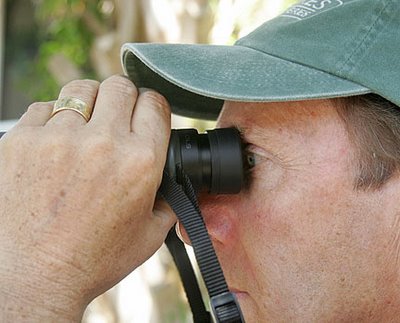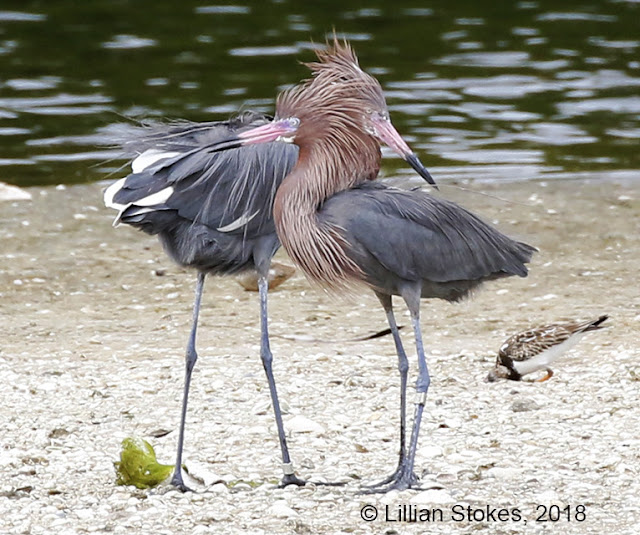 Adjust the binoculars for your individual needs
Adjust the binoculars for your individual needs
 When not wearing eyeglasses, turn the binocular eyecups up, when wearing eyeglasses, turn the eyecups down
When not wearing eyeglasses, turn the binocular eyecups up, when wearing eyeglasses, turn the eyecups down
 Tuck your elbows in to help steady the binoculars
Tuck your elbows in to help steady the binoculars
 Enjoy the beautiful birds
Enjoy the beautiful birds
Are you confused about how to use your binoculars, or have not been using them correctly? Here are some tips to help you learn how to get the most out of your binos so you can enjoy those beautiful birds more!
LILLIAN AND DON'S BINOCULAR TIPS
1. Up, Down
If you are wearing eyeglasses turn the
eyecups DOWN. If you are not wearing eyeglasses, turn the
eyecups to the UP position. Many binoculars, especially higher end models, have
eyecups that can be adjusted in several positions. Only when you have the
eyecups in the right position for you, will you clearly see the whole field of view.
If you are sharing binoculars among several people, make sure each person, in turn, adjusts the
eyecups in the right position for their eyes when they look through the binoculars.
2. Eye Relief
The distance behind the eyepiece where you can see the whole field of view is called the
binocular’s eye relief. If your eye is farther back from that spot (which can happen when you wear eyeglasses), you will not see the whole field of view. By turning the
eyecups down you can compensate for wearing eyeglasses and move your eye closer to that magic spot. Binocular eye relief is indicated in millimeters. Look for binoculars that have an eye relief of at least 15 or 16 mm.
3. Wear your glasses
If you wear glasses, keep them on when using binoculars, even if you wear progressive lenses or bifocals. With good binoculars, you should be able to see through them perfectly fine. Besides, if yo
u’re not wearing your glasses how will you find the birds so you can then view them through your
binos? If you are having trouble with this, consider upgrading your
binos.
4. Move the Barrels
Move the binocular barrels closer together, or farther apart depending on the distance between your eyes.
5. What do the numbers mean?
On binoculars you will see numbers such as 8 x 42, 10 x 42, 7 x 35, 12x 50, 8 x 25, etc. The first number indicates the power of the binocular. So 8 power binoculars magnify the object you are looking at 8 times.
The second number, such as 42, 35, 50, refers to the measurement, in millimeters, of the diameter of the lens (called the objective lens) at the far end of your binocular. May seem a little complicated, but what it means is the higher this number, the more light the binocular will let in, in general. A binocular with a 42 mm objective lens, will let in more light than one with a 25 mm objective lens.
6. Field of ViewIn the
binocular’s specifications the width of the field of view is stated as something like 383 ft. at 1000
yds. A
wide field of view makes it easier to spot and follow birds,
especially for beginners. Sometimes it is expressed as an angle such as 7.3 degrees. Many 8 power binoculars have fields of view in the mid 300s to over 400 range.
7. Get the right binocular for your needs
Here we are discussing binoculars for birding. In our opinion, in most cases, the best binoculars for all purpose birding are full size binoculars that are 8 x 42 or 8 x 40. These provide a good amount of magnification and bright images.
Binoculars that are more powerful magnify hand shake so they are more difficult to hold still. This is especially true if you have been birding all day and your arms are fatigued. They generally also have a more narrow field of view and shallow depth of field. It makes it a little more difficult to find the bird and have a steady image. Having said that, there are many people, ourselves included, who are experienced enough at spotting birds and handling binoculars to deal with these issues and happily use 10 power
binoculars. People may want 10 power binoculars if they are in situations where they are always viewing birds at a distance. We often use 10 power binoculars when at places such as lakes, marshes and the ocean, where we know the birds will be farther away. Then the 10 power is a big plus.
What about compact binoculars? They may offer good magnification such as 8 power, but usually have a lower number for the objective lens, such as 25 or 26, and, in general, do not let in as much light as full size models. Modern advances and internal coatings have improved the light gathering of compact models. The lightweight and small size of compacts make them extremely attractive for some people. Ironically, because of their lightness, hand tremor can be magnified.
Compacts can be great for many situations such as, hiking, backpacking, kayaking,
canoeing, airline travel, carrying in purse or pocket, or you just want a pair on your kitchen table to watch feeder birds. They can be good for kids because of their small size. In general though, for all day, all around birding, full size are preferred.
Another way to deal with binocular weight is to use a shoulder harness which takes the weight off your neck and redistributes it.
6. What’s this about a diopter adjustment?
If you have normal vision, or properly corrected vision with eyeglasses, you probably don’t
need to adjust the diopter. If vision in one of your eyes is different than the other, you may need to adjust the diopter. The
dipoter is
a ring on the right barrel of the binocular below the eyepiece. Here’s how
to do it.
- Close your right eye. While looking through only your left eye, pick a distant object and focus the binoculars on it.
- Close your left eye and (don’t turn t
he focus knob) while looking at the same object, turn the diopter ring on the binocular until the object is in sharp focus.
- Now you’re done. L
eave the diopter ring in that position and resume birding, looking through both eyes and using the center knob to focus.
Don't forget your
The New Stokes Field Guide to Birds, eastern or western region, so you can look up what you see!
Enjoy!




































